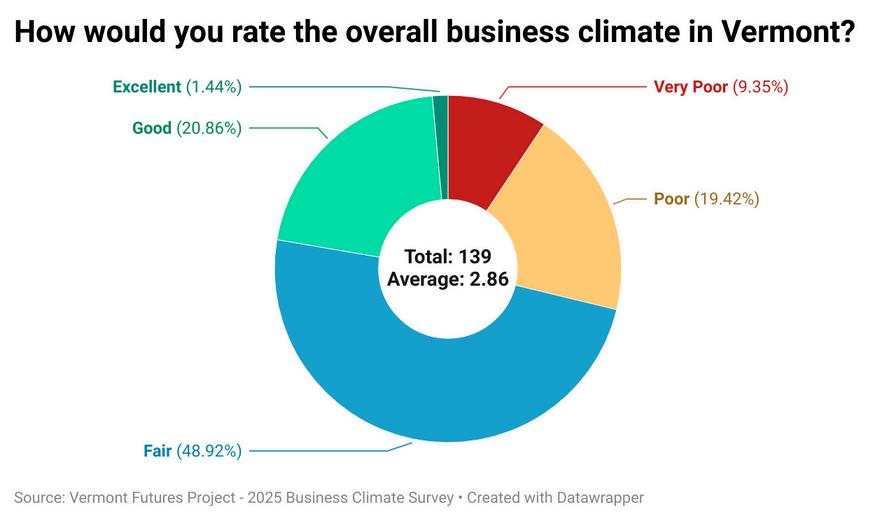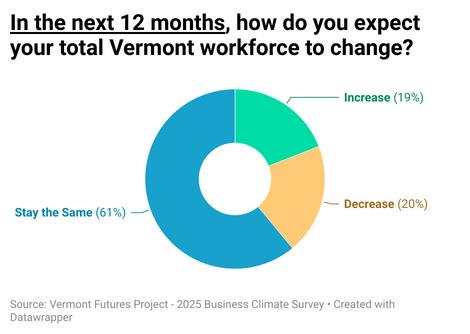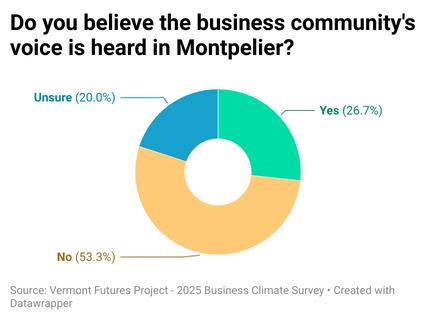






The Vermont Futures Project is a 501(c)(3) non-profit organization dedicated to answering this mission question: “How can we use data to support the evolution of Vermont’s economy towards a thriving future full of opportunity for all?” This question guides our non-partisan research and education, and generates partnerships that elevate data-informed planning and recommendations.
2025 Vermont Business Climate Survey Findings Report

Vermonts competitiveness, affordability, and long term economic potential.
The results offer a clear and consistent message. Vermont businesses continue to navigate persistent structural challenges including workforce shortages, housing scarcity, rising operating costs, and a regulatory landscape that many perceive as complex and unpredictable Employers rated Vermont’s overall business climate 286 out of 5, a middle-of-thescale sentiment that mirrors last year’s results and reflects cautious expectations for the year ahead
The findings point to five themes that appear across regions, sectors, and employer size. Workforce pressures remain a defining challenge as businesses struggle to recruit and retain employees in a high-cost environment. Housing affordability continues to limit talent attraction and mobility, reinforcing the importance of expanding Vermont’s housing supply. Rising costs, including taxes and health insurance premiums, weigh heavily on growth and investment decisions. Employers express continued concern about the predictability of Vermont’s regulatory processes. Many also report feeling that their voices and perspectives are not fully incorporated into policy discussions.
Despite these challenges, the survey also highlights a resilient business community that remains committed to Vermont and invested in its longterm success Respondents represent the full breadth of the state’s
economy including manufacturing, healthcare, tourism and hospitality, agriculture, technology, professional services, and nonprofit organizations Their insights provide a valuable foundation for understanding the economic conditions that affect every region and sector
The Vermont Futures Project uses this survey, along with the Vermont Economic Action Plan and the forthcoming Competitiveness Dashboard, to provide independent economic research and analysis that helps Vermont turn long-term planning into actionable policy. These tools offer policymakers, business leaders, and community partners a grounded understanding of the economic realities facing employers and a clear path toward improving affordability, expanding opportunity, and strengthening Vermont’s workforce and communities.
We appreciate the employers who contributed their time, experience, and perspectives to this year’s survey. Their participation ensures that the Vermont Futures Project continues to serve as a trusted and credible source of economic insight for the state

Kevin Chu Executive Director Vermont Futures Project
The story of this survey begins with the employers who shape Vermont’s economy every day. The one hundred and thirty nine respondents represent all fourteen counties and reflect the full range of industries identified in the Vermont Economic Action Plan as essential to the state’s long term economic vitality These include manufacturing firms that anchor local supply chains, healthcare organizations that sustain community wellbeing, hospitality and tourism businesses that fuel regional economies, professional service providers, agricultural producers, educators, technology innovators, and nonprofit organizations
This diversity provides Vermont with a clear view of the economic landscape as it exists today It reveals how shared challenges look across different communities and how Vermont’s unique regional strengths interact with statewide issues such as housing scarcity, workforce shortages, and rising costs. The perspectives captured in these responses help illustrate where progress toward the goals outlined in the Vermont Economic Action Plan is beginning to take shape and where barriers continue to limit Vermont’s ability to grow, attract new residents, and support strong communities.
Understanding the characteristics of the businesses and sectors represented in this survey strengthens the foundation for every insight that follows. These voices reflect the lived experience of employers who are deeply invested in Vermont’s success, and their perspectives help ensure that long term planning efforts remain grounded in the realities of the people who keep the state’s economy moving



The overall business climate rating of two point eight six out of five provides a meaningful snapshot of where Vermont stands today. Employers express a mix of commitment and concern. They remain dedicated to their communities and their employees, but they also face rising operating costs, workforce shortages, and regulatory processes that often feel time consuming or unpredictable.
From the perspective of the Vermont Economic Action Plan, this rating is a vital indicator It shows that Vermont’s economic foundation is holding steady but is not yet experiencing the broad based momentum that is needed to support growth, attract new workers and families, and ensure long term affordability. The results suggest that Vermont has an opportunity to build greater predictability, strengthen the housing and workforce systems that employers rely on, and improve conditions for investment across the state
This sentiment also underscores the importance of focusing on the structural issues that shape business decision making. When the environment becomes more stable and more affordable, employers become more willing to invest, expand, innovate, and contribute more fully to Vermont’s shared prosperity.

The challenges identified in this section closely mirror the core priorities of the Vermont Economic Action Plan. Workforce shortages remain the most frequently cited concern. Many employers cannot fill open positions, which limits their ability to meet demand, expand operations, or plan for the future. Housing affordability and availability are also prominent barriers. When employees cannot find housing close to their jobs or struggle with cost, businesses face recruitment delays, retention issues, and higher turnover
Healthcare costs continue to rise, and taxes and fees compound the affordability challenges businesses face. These concerns influence wage decisions, benefit offerings, and the ability of employers to remain competitive. Employers also frequently cite the predictability of regulatory processes as an important factor shaping their planning, investment, and confidence in long term operations
Each of these issues affects more than businesses alone They touch every aspect of Vermont life, from the vitality of downtowns to the stability of families to the resilience of communities. The Vermont Economic Action Plan identifies these issues as central to Vermont’s future because they determine whether Vermont can grow its population, support innovation, and remain a place where people who want to live and work here can do so
The alignment between employer concerns and the priorities of the Vermont Economic Action Plan reinforces the importance of long term solutions that support affordability, opportunity, and economic stability.

Workforce pressures are not new for Vermont, but the data in this report underscores just how strongly they continue to define economic life across the state. Many employers report difficulty finding qualified workers, filling essential positions, or competing with a limited pool of applicants. These challenges intersect with broader demographic trends, including Vermont’s aging population and the rate at which young people and working age families enter or leave the state
These findings directly connect to what the Vermont Economic Action Plan identifies as one of Vermont’s most urgent long term needs. To remain economically vibrant, Vermont must add thirteen thousand five hundred people to its workforce each year. Achieving that goal requires a combination of retaining more high school and college graduates, recruiting workers from outside Vermont, and increasing participation among Vermonters who are currently not in the labor force
The experiences reflected in these charts highlight why the strategies in the Vermont Economic Action Plan are so important. Without a larger and more accessible workforce, Vermont’s ability to grow, innovate, and maintain essential services will remain limited. These findings provide a clear call to action for efforts that expand housing, support families, strengthen training pathways, and make Vermont an attractive place for new residents



The business performance data reveals an economy that is stable but not yet accelerating. Many employers report that they are holding steady but see limited opportunity for substantial growth in the coming year. They continue to serve their communities and meet current demand, but they do so while navigating cost pressures and workforce shortages that limit their ability to expand.
This steady but constrained environment aligns closely with the concerns identified in the Vermont Economic Action Plan Vermont’s long term economic future depends on its ability to shift from slow and steady activity to sustainable growth. To make that shift, the state will need to improve affordability, strengthen workforce availability, and reduce barriers to investment so that employers feel confident about pursuing long term opportunities
The insights in this section highlight the importance of establishing the right conditions for growth With clearer pathways, greater predictability, and stronger support systems, businesses will be better able to invest in the future, take calculated risks, and contribute to Vermont’s overall economic momentum.


Healthcare costs continue to present challenges for employers across all regions and industries. Rising premiums and limited options for competitive benefits influence decisions about wages, staffing, and long term planning. These pressures affect employees and employers alike, shaping the financial security of households and the stability of businesses.
The Vermont Economic Action Plan identifies the cost of healthcare as one of the critical factors influencing both affordability and economic stability When healthcare costs rise faster than wages or revenue, businesses face difficult choices that affect the overall quality of jobs available in the state.
These findings highlight the importance of greater affordability and transparency within the healthcare system They also reinforce the role that long term systemic improvements can play in strengthening Vermont’s economic foundation and supporting both employers and employees



The investment outlook charts show that many Vermont employers are delaying or scaling back long term investments due to uncertainty around staffing, costs, and the regulatory environment. Employers want to grow and expand, but many feel they do not yet have the conditions they need to move forward with confidence.
This hesitation reflects some of the core themes of the Vermont Economic Action Plan Vermont can unlock more dynamic economic activity when the environment becomes more predictable, affordable, and supportive of long term planning Employers who feel confident about their ability to hire workers, navigate permitting, and manage costs are more likely to invest in equipment, facilities, and innovation.
These insights point to a significant opportunity By aligning statewide efforts with the strategies in the Vermont Economic Action Plan, Vermont can build the conditions that support stronger investment, higher levels of innovation, and sustained economic resilience



The findings on economic stewardship highlight employers’ desire for stability and clarity in Vermont’s fiscal and economic strategy. Concerns about spending levels, taxes, and long term sustainability shape how businesses plan for the future and influence their willingness to take on new projects.
These perceptions directly connect to the Vermont Economic Action Plan, which emphasizes thoughtful, responsible decision making as a foundation for long term economic health Vermont’s fiscal choices influence everything from housing development to workforce participation to the overall affordability of living and doing business in the state.
This section of the survey shows that employers are eager to see long term planning and economic strategy move forward with clear priorities and shared direction Their perspectives highlight the value of a unified approach to economic stewardship that strengthens confidence and supports a more predictable future for employers and communities.


These findings offer more than sentiment. They reveal how connected employers feel to the decisions shaping Vermont’s future and how confident they are that their lived experiences are understood by the people representing them.
The first chart shows that more than half of respondents do not believe the voice of the business community is being heard in Montpelier Only about one quarter feel their views reach decision makers, and many remain unsure This points to a growing sense of distance between daily business realities and statewide policy conversations, especially as employers continue to navigate rising costs, workforce shortages, housing pressures, and regulatory complexity.
The second chart reinforces this concern A strong majority of respondents are very concerned or somewhat concerned about whether elected officials understand the economic pressures employers face. Only a small share feel confident that policymakers fully grasp the challenges influencing hiring, investment, affordability, and long term planning.
These results matter because perception influences behavior When employers feel unheard or misunderstood, confidence declines Investments are delayed Innovation slows Planning becomes cautious rather than bold Strong communication and trust are essential ingredients for a resilient and competitive economy, and these charts highlight the need for more meaningful engagement between Vermont’s business community and its policymakers.
The Vermont Futures Project helps support this connection by gathering independent data, elevating employer experiences, and translating economic realities into clear insights. This work helps ensure that Vermont’s economic decisions are grounded in both rigorous analysis and the real conditions facing businesses.
Together, these findings point to a significant opportunity. Vermont can strengthen its economic future by creating more effective channels for listening, learning, and aligning policy with the day to day realities of employers across the state


The findings in this report paint a picture of a Vermont that is full of potential yet facing meaningful barriers to long term economic prosperity. Employers remain committed to their communities and invested in the future of the state, but they continue to navigate challenges related to affordability, workforce, housing, healthcare, and confidence in statewide policy and economic direction.
These findings closely align with the priorities and long term goals of the Vermont Economic Action Plan Together they offer a roadmap for strengthening the conditions that support a vibrant, resilient, and inclusive economy. The path forward requires collaboration across sectors, clear communication between policymakers and employers, and sustained commitment to data informed planning.
Through independent economic research and the ongoing development of the Vermont Economic Action Plan, the Vermont Futures Project plays a central role in guiding this work The insights provided in this report bring Vermont closer to the solutions needed to achieve a thriving future for all people and all places across the state.
The Vermont Futures Project remains dedicated to serving as a trusted resource for employers, policymakers, and community partners as we work together to build a stronger, more affordable, and more prosperous Vermont
BE AN AMBASSADOR
We need you to help share data and insights in your network
VISION FOR THE FUTURE Scan for the digital version of the Economic Action Plan
DONATE TODAY
We invite you to invest in Vermont’s future